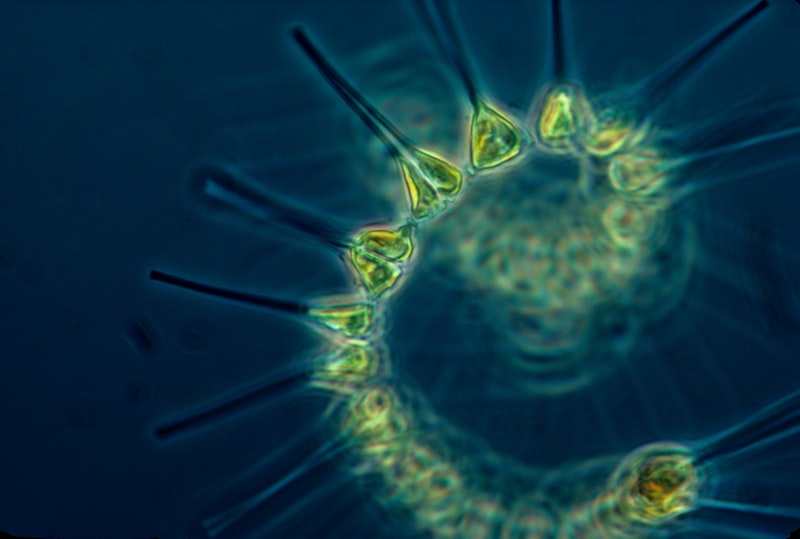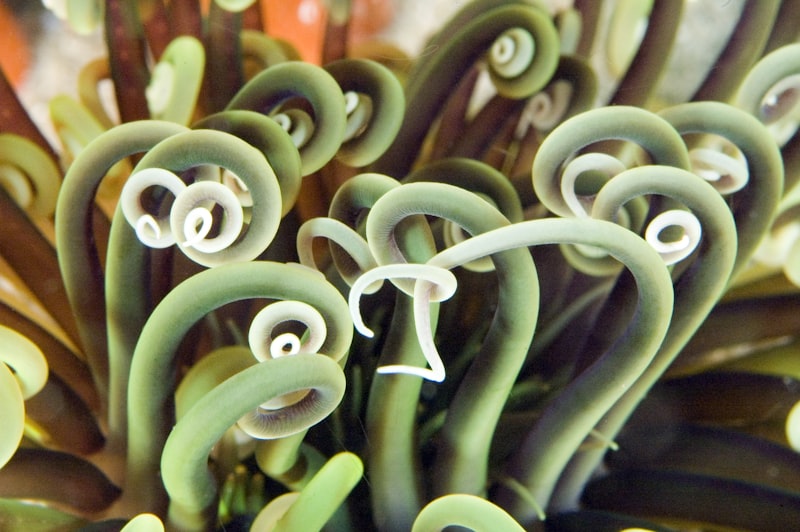Imagine the sea cucumber, a master of metamorphosis in the depths. Its hormonal orchestra directs everything from larval development to regeneration after injury. When conditions are just right, these hormones trigger a cascade of events, prompting the sea cucumber to undergo profound changes in body shape and function.
Similarly, corals, those architects of the reef, depend on hormonal cues to synchronize their spawning events with lunar cycles. This delicate dance ensures that millions of tiny gametes are released into the water simultaneously, maximizing the chances of successful fertilization and offspring survival.
And let’s not forget the octopus, renowned for its intelligence and adaptability. Behind its color-changing camouflage lies a sophisticated endocrine system that governs not only its camouflage abilities but also its complex behaviors and mating rituals. Hormonal signals enable these creatures to communicate effectively and make split-second decisions crucial for survival.
In the vast expanse of the ocean, where every adaptation counts, hormonal regulation in marine invertebrates underscores the beauty of evolution’s fine-tuned mechanisms. From the tiny sea urchin to the majestic jellyfish, each species has evolved unique hormonal pathways tailored to its specific ecological niche.
As we delve deeper into understanding these mechanisms, we uncover nature’s ingenious solutions to life’s challenges. Hormonal regulation in marine invertebrates reveals a world where chemical whispers govern the rhythms of life beneath the waves, a testament to the marvels of adaptation and survival in Earth’s most ancient habitats.
Unveiling the Secrets: Hormonal Pathways of Growth in Marine Invertebrates
Ever wondered how marine invertebrates, those fascinating creatures of the ocean depths, manage their growth in such diverse and often challenging environments? The answer lies in their intricate hormonal pathways, a marvel of evolution’s ingenuity.
In the realm of marine biology, understanding how these creatures grow and develop has long been a subject of fascination and scientific inquiry. Unlike terrestrial animals, marine invertebrates like corals, mollusks, and sea stars rely on a complex interplay of hormones to regulate their growth processes.
One key hormone central to this process is ecdysone, known for its role in molting and metamorphosis. Similar to how insects shed their exoskeletons, marine invertebrates undergo molting phases where they shed their old outer layers to accommodate growth. This hormone acts as a signal, triggering the molting process and facilitating the growth of a new exoskeleton or shell.
Moreover, juvenile hormone plays a crucial role in determining the overall growth trajectory of these organisms. It acts not only as a regulator of growth but also influences other physiological processes such as reproduction and metabolism. Think of it as a conductor orchestrating a symphony of growth and development within the confines of the ocean’s depths.
But perhaps the most intriguing aspect of these hormonal pathways is their adaptability. Marine invertebrates have evolved mechanisms that allow them to adjust their growth rates in response to environmental cues such as temperature, salinity, and food availability. This adaptive flexibility ensures their survival in ever-changing marine ecosystems.
In essence, the hormonal pathways of growth in marine invertebrates are a testament to nature’s brilliance. They not only enable these creatures to thrive in the harsh and competitive world of the ocean but also offer insights into fundamental biological processes that have implications far beyond the marine realm.
As researchers delve deeper into these secrets, new discoveries await, promising to unveil even more about the intricate mechanisms that govern life beneath the waves.
How Hormones Control Behavior: Insights from Marine Invertebrate Research
In the depths of the ocean, scientists have been studying creatures like octopuses, squid, and even sea slugs to understand how their hormones impact their behavior. These creatures may seem vastly different from us, but surprisingly, many of their hormonal systems work in similar ways to ours.
Take the California sea hare, for example. This large sea slug has become a star in neurobiology research because of its giant neurons, which are much easier to study than those in more complex animals. Researchers have found that serotonin, a neurotransmitter also found in humans, plays a crucial role in its feeding and mating behaviors. When serotonin levels rise, the sea hare becomes more active in searching for food or mates.
Octopuses, known for their intelligence and problem-solving abilities, also provide valuable insights. These cephalopods use a variety of hormones to regulate their complex behaviors, from camouflage to aggression. Studies have shown that hormones like dopamine affect their ability to learn and remember, which is essential for survival in their ever-changing environment.
Even coral reefs, home to countless marine species, are not exempt from hormonal influences. Coral larvae, tiny and fragile, rely on hormones to find suitable places to settle and grow into coral colonies. This process, known as metamorphosis, is crucial for the health and diversity of coral reef ecosystems worldwide.
From Larvae to Adults: Hormonal Metamorphosis in Marine Invertebrates
In marine invertebrates, hormonal metamorphosis begins with the activation of specific genes triggered by environmental cues such as temperature, light, and chemical signals in the water. These cues act as a switch, signaling the larva to begin its journey towards adulthood. Hormones like ecdysteroids and juvenile hormones play pivotal roles in regulating this transformation. Ecdysteroids, for instance, control molting cycles, crucial for shedding old exoskeletons and growing into larger forms.
The larval stage itself is often specialized for dispersal and survival in open waters, where competition for resources is fierce. As the larva prepares for metamorphosis, it stops feeding and undergoes internal reorganization. Cells destined for specific adult structures begin to differentiate, guided by hormonal signals that coordinate their development.
Metamorphosis culminates in the emergence of an adult form tailored for its particular ecological niche. For instance, a larval barnacle, initially free-swimming, settles and undergoes metamorphosis to become sessile, anchored to rocks or other surfaces. This transformation involves not only structural changes but also behavioral adaptations, such as feeding mechanisms optimized for filter-feeding.
Understanding hormonal metamorphosis in marine invertebrates is not just a matter of biological curiosity but also holds practical implications. It sheds light on evolutionary processes, ecological interactions, and even informs strategies for marine conservation and aquaculture. By deciphering the intricate dance of hormones and developmental pathways, researchers gain insights into how these organisms thrive in diverse marine environments.
Hormonal metamorphosis in marine invertebrates exemplifies nature’s ingenuity in adapting to life in the oceans. From tiny larvae to fully formed adults, this journey underscores the complexity and resilience of marine lifeforms against the backdrop of ever-changing environmental conditions.
Survival Strategies: Hormonal Responses to Environmental Stress in Marine Invertebrates
Ever wondered how marine creatures endure harsh environmental conditions that would leave most of us humans struggling for breath? It turns out that marine invertebrates have some fascinating tricks up their sleeves, particularly when it comes to handling stress. When we talk about stress in this context, we’re not referring to deadlines or traffic jams but rather the challenges posed by their underwater habitats.
One of the key survival strategies that these creatures employ revolves around their hormonal responses. Yes, you read that right—marine invertebrates have hormones too, and they play a crucial role in helping them adapt to changes in their surroundings. Imagine these hormones as tiny messengers within their bodies, constantly assessing the environment and signaling appropriate responses.
For instance, when faced with rising water temperatures or changes in salinity, marine invertebrates like corals or sea urchins kickstart their hormonal machinery. These hormones help regulate various physiological processes, from metabolism to growth and reproduction. It’s like their own built-in emergency response system, ensuring they can cope with whatever Mother Nature throws their way.
Interestingly, these hormonal responses can vary greatly between different species and even within the same species depending on their geographical location or specific habitat. It’s a bit like how people from different parts of the world have unique adaptations to their local climates—except in this case, it’s happening underwater and on a much smaller, cellular scale.
Scientists studying these hormonal responses are not just doing it out of curiosity (though there’s plenty of that). Understanding how marine invertebrates cope with environmental stress can provide invaluable insights into how we might protect and preserve these fragile ecosystems in the face of climate change and human activity.
So, the next time you marvel at the colorful diversity of coral reefs or the tenacity of a hermit crab, remember that behind their seemingly simple exteriors lies a complex world of hormonal wizardry, helping them survive and thrive in even the most challenging of underwater environments.
The Role of Hormones in Reproduction Among Sea Creatures: A Deep Dive
In this underwater world, hormones serve as messengers, transmitting signals that trigger pivotal events like spawning and mating. Take, for instance, the reproductive cycle of corals. When conditions are optimal, specific hormones prompt corals to release their gametes simultaneously, a phenomenon crucial for fertilization and genetic diversity.
Similarly, in marine mammals such as whales and dolphins, hormones regulate the timing of reproduction, syncing births with periods of abundant food supply and favorable environmental conditions. This synchronization enhances offspring survival chances, ensuring they enter a world where resources are plentiful.
For crustaceans like lobsters and crabs, hormones dictate molting and reproductive readiness. Molting, the process of shedding old exoskeletons to grow larger, is intricately tied to hormonal cycles that also influence mating behaviors and fertility. Hormones guide these creatures through a delicate dance of growth, regeneration, and reproduction.

Analogous to terrestrial organisms, sea creatures rely on hormones for sexual differentiation and development. In some species, environmental factors such as temperature fluctuations can influence hormone levels, impacting reproductive success. This sensitivity underscores the adaptability of marine life to changing oceanic conditions, highlighting the interconnectedness between hormone regulation and environmental cues.
Regulation Underwater: Hormonal Signaling Networks in Marine Invertebrates
In the vast oceans, where life teems in myriad forms, marine invertebrates rely on intricate hormonal systems to maintain balance and communicate vital information. These creatures, from colorful corals to elusive octopuses, employ a diverse array of hormones that regulate growth, reproduction, and response to environmental cues.
Imagine the bustling reef where tiny sea anemones release chemical signals into the water, triggering a chain reaction among neighboring organisms. This chemical dialogue, governed by hormones, helps them coordinate behaviors like feeding and reproduction, ensuring survival in their dynamic habitat.
One of the key players in this underwater drama is serotonin, often associated with mood regulation in humans but equally crucial for marine invertebrates. Serotonin influences various physiological processes, from controlling muscle contractions in jellyfish to modulating feeding behaviors in sea stars. Its role underscores the evolutionary conservation of hormonal pathways across different species.
Beyond serotonin, another hormone, dopamine, takes center stage in the brains of some marine invertebrates, affecting their sensory perception and motor control. Picture a sea slug navigating through kelp forests, guided by dopamine-mediated signals that enable precise movements and responses to external stimuli.
Moreover, ecdysteroids, known for their role in molting and development in insects, also play a significant role in marine invertebrates. These hormones orchestrate the complex life cycles of crustaceans and other species, ensuring timely transitions from larval stages to adulthood in the challenging oceanic environment.
As we delve deeper into the underwater world, the intricate web of hormonal signaling networks reveals itself as a marvel of adaptation and survival. Each species has evolved unique strategies to utilize these chemical messengers effectively, fine-tuning their responses to changing environmental conditions and biological rhythms.
Understanding these hormonal dynamics not only sheds light on the resilience of marine ecosystems but also holds promise for applications in marine conservation and biotechnology. By deciphering the language of hormones in marine invertebrates, scientists unlock new possibilities for safeguarding biodiversity and exploring nature’s pharmacopeia for potential medical breakthroughs.
In this aquatic realm where every interaction is choreographed by chemical cues, the study of hormonal signaling networks opens a window into the mesmerizing complexity of life beneath the waves.
Impact of Climate Change: How Hormonal Systems in Marine Invertebrates Adapt
Imagine this: you’re a tiny coral polyp, living in a vibrant underwater reef. Suddenly, the water around you starts warming up. It’s like being in a bathtub that keeps getting hotter and hotter. For marine invertebrates, this rise in temperature can disrupt their delicate hormonal balance. Hormones control crucial functions like growth, reproduction, and behavior. When these systems are thrown out of whack by climate change, it can spell trouble for the entire species.
Take the majestic sea turtles, for example. These ancient creatures rely on hormone-regulated cues to nest on specific beaches. With rising sea levels due to melting ice caps, their nesting grounds are shrinking. The hormonal systems that guide their migrations and reproductive cycles are struggling to adapt to these rapid environmental changes.
In the world of marine biology, adaptation is key to survival. Some species of marine invertebrates are showing remarkable resilience in the face of climate change. They’re adjusting their hormonal responses to cope with warmer waters and more acidic oceans. It’s like they’re rewiring their internal systems to stay one step ahead of the environmental challenges.
But not all marine invertebrates are able to adapt fast enough. Some species are already experiencing declines in population numbers or struggling to reproduce successfully. The intricate dance of hormones that once ensured their survival is now being disrupted by human-induced climate change.
Scientists are closely studying these hormonal adaptations in marine invertebrates to better understand how these creatures might cope in the future. By unraveling the mysteries of their hormone systems, researchers hope to find ways to protect and conserve vulnerable species in our changing oceans.

So, the next time you dip your toes into the ocean or marvel at a coral reef, remember the incredible resilience of marine invertebrates. Their hormonal systems, finely tuned over millions of years of evolution, are now facing their ultimate test in the era of climate change.
Frequently Asked Questions
How do environmental factors affect hormonal regulation in marine invertebrates?
Environmental factors significantly influence hormonal regulation in marine invertebrates. Factors such as temperature, salinity, pH levels, and pollutants can alter hormone production and activity, affecting growth, reproduction, and overall physiological processes in these organisms.
What are some examples of experimental studies on hormonal regulation in marine invertebrates?
Explore various experimental studies that investigate hormonal regulation in marine invertebrates. Discover insights into how hormones influence growth, reproduction, and behavior in species like sea urchins, mollusks, and crustaceans.
What roles do hormones play in the metamorphosis of marine invertebrates?
Learn about the crucial roles hormones play in guiding the metamorphosis of marine invertebrates. Understand how these chemical messengers orchestrate complex physiological changes, driving larval development into adult forms.
What are the key hormones involved in regulating growth and development in marine invertebrates?
Discover the key hormones that regulate growth and development in marine invertebrates. Explore how these hormones influence various stages of life, from larval to adult forms, shaping their biological processes and environmental interactions.
How do hormones influence reproductive cycles in marine invertebrates?
Discover how hormones play a crucial role in regulating reproductive cycles among marine invertebrates, influencing processes like spawning and larval development. Learn about the specific hormones involved and their impacts on reproductive behaviors and timing.


